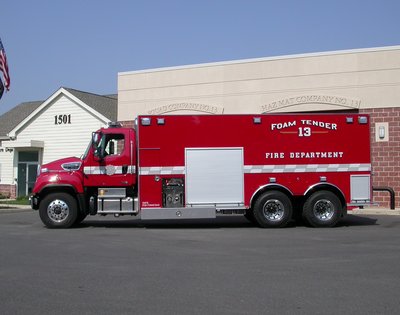Most people know that oil and water don’t mix. Neither does water with fuels and chemicals, especially if they happen to be on fire.
Water, according to some fire experts, can actually cause a chemical fire to spread. A city like Bayonne is a storehouse for an alphabet soup of chemicals, nearly all of them flammable. Here, hazardous material crews must find new and more expedient ways to deal with gasoline, oil spills, or chemical spills that have a risk of erupting into flames, as well as suppressing those that have already ignited.
Water, in fact, when applied to a fuel or chemical fire, can boil off and spread the fuel it was supposed to extinguish.
“Foam,” according to Bayonne Fire Chief Greg Rogers, “extinguishes by blanketing, suffocating, cooling and preventing vapor rise. Firefighting foam is a specialized agent that is used for the suppression of most flammable liquid fires. Form is normally used to extinguish hydrocarbon fires such as heading oil, diesel, kerosene, and gasoline; and polar solvent fires such as alcohol, esters and keytones.”
Thanks to a $685,000 Port Security grant from the Department of Homeland Security, the city now has a 4,000-gallon foam tender to be used specifically for petro/chemical fires.
“The foam tender will serve as a mechanism of rapid delivery and deployment of firefighting foam to petro-chemical emergencies,” Rogers said.
This is 4,000 gallons of concentrate that, when mixed with water, is capable of producing 400,000 gallons of foam solution used for extinguishing alcohol and hydrocarbon based fires, Rogers said, and can be pumped directly to a truck for quick high capacity application.
“The foam tender will serve as a mechanism of rapid delivery and deployment of firefighting foam to petro-chemical emergencies.” – Fire Chief Greg Rogers
__________
The history of foam
The Bayonne Fire Department has long used foam as part of its firefighting efforts, battling one of the more serious harbor fires in the mid-1980s with such foam. As recently as last January, the BFD was involved in a mutual aid effort with the town of Kearny when a tractor trailer carrying 8,000 gallons of fuel overturned on the Newark Turnpike.
Fire-suppressing foam has been around for more than a century to help coat a fire and coat the fuel, basically suffocating the fire by denying it oxygen. Since the 1950s, foam has been widely used in those situations where water and other fire suppression agents are either ineffective or positively dangerous.
But in the past, it has been a cumbersome and labor-intensive effort.
“The Bayonne Fire Department currently carries approximately 40 55-gallon drums of foam concentrate that must be painstakingly handled by the barrel and drafted by pickup tubes, which is a manpower intensive operation,” Rogers said.
In a city that is constantly at risk of a chemically-fueled fuel fire erupting from a storage facility or a tanker, a city crisscrossed by highways over which fuel trucks nearly constantly travel, risking an accident, some other way had to be found to distribute foam. The new foam tender will solve that problem.
